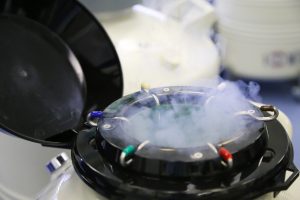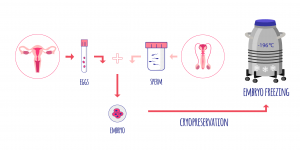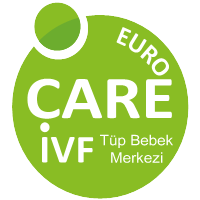 As you’re getting ready for your IVF cycle, a lot of questions may cross your mind, including the possibility of freezing any extra embryos. If your cycle isn’t successful, these embryos can be used in your next treatment. Alternatively, you can use these embryos to complete your family with a second (or even a third) child in the future. If you have a disease such as cancer or if you’re about to start treatment that may affect your fertility, embryos freezing is a great way to preserve your reproductive options.
As you’re getting ready for your IVF cycle, a lot of questions may cross your mind, including the possibility of freezing any extra embryos. If your cycle isn’t successful, these embryos can be used in your next treatment. Alternatively, you can use these embryos to complete your family with a second (or even a third) child in the future. If you have a disease such as cancer or if you’re about to start treatment that may affect your fertility, embryos freezing is a great way to preserve your reproductive options.
What is embryo freezing exactly?
Embryo freezing (also known as embryo cryopreservation) is the process of cooling embryos to subzero temperatures to preserve their quality and viability for future conception. At the EuroCARE IVF clinic, we use vitrification (also known as flash freezing) to freeze embryos within minutes — without damaging the cells.

Rapid cooling is necessary to prevent the toxicity of cryoprotectants at room temperature and prevent the formation of ice crystals. Then embryos will be stored in special tanks of liquid nitrogen until you’re ready to use them.
Not all embryos are suitable for freezing so only those of high quality will be chosen for the procedure. Embryos can be frozen at different stages of their development either when they’re at the two-to-eight-cell stage (known as the cleavage stage) or later in their development (called the blastocyst stage).
Embryo thawing: the reverse process of cryopreservation
To be able to use frozen embryos, they should be first warmed both in air and in a water bath at a much faster rate than the cooling rate. Embryos are warmed to room temperature and then to body temperature. Once they reach the ideal temperature, an embryo transfer procedure will be performed within two to four hours.
Not all embryos will survive the freezing and thawing process. It’s not uncommon for embryos to lose a cell or two, recover and continue to develop. Our IVF specialist will discuss with you whether your embryo(s) are suitable for freezing and a subsequent transfer.
Transferring frozen embryos
The procedure of transferring previously frozen embryos is called frozen embryo transfer (FET).
The initial step is to check whether you are ovulating regularly by using urine or blood tests. If your periods are regular, your EuroCARE IVF doctor may suggest having the embryo transferred to your womb without using fertility drugs. Ultrasound scans will be used to check the lining of your womb.
If your periods aren’t regular or are absent, your doctor may suggest using drugs to prepare the womb lining for the transfer. When the lining becomes thick enough, embryos will be first thawed and then implanted into your womb in an attempt to establish a pregnancy.
Is embryo freezing for you?
You may use this technique if:
- You want to try conception via IVF in the future.
- Your treatment needs to be cancelled due to ovarian hyperstimulation.
- You have cancer or need to undergo a medical procedure (such as cancer treatment or surgery) which may affect the ovaries.
- You want to postpone pregnancy until you feel ready and want to create embryos with your partner for future family building.
- If you’re a female transitioning to a male, you may want to preserve your fertility before you start hormone therapy or have reconstructive surgery.
Your EuroCARE IVF doctor will advise the next steps based on the quality and quantity of your remaining embryos and will let you know if embryo freezing would be beneficial for you.
Legal aspects of embryo freezing
Before your embryos are frozen, you must sign a formal agreement which covers the following aspects of the procedure:
- How long you want the embryos to be stored for
- What should happen to your embryos if you or your partner were to die or to separate
- Any other conditions you may have for the use of your embryos
The EuroCARE IVF centre allows you to keep your embryos frozen for an unlimited period. Each year you will need to pay a small fee for storage.
You, your partner or the donor(s) (if you use any) can change or withdraw the consent at any time before the embryos are used in treatment. If your partner withdraws their consent, then your embryos cannot be used for conception.
How successful is the procedure?
Success rates for FET cycles have been increasing over the years and are now comparable to the rates of IVF using fresh embryos.
The success of your cycle depends on multiple factors, including your age. Women aged under 35 have better pregnancy rates using fresh embryos, while the rates for women aged between 35-37 are level with the rates of fresh embryo cycles. Women aged over 37 have greater success with frozen embryos as these were created using eggs collected at the time when the woman was at her peak fertility.
Make the right decisions for your fertility future with EuroCARE IVF!
The ability to freeze and thaw embryos successfully is one of the greatest advancements in assisted reproductive technology. Many fertility patients who undergo in vitro fertilisation (IVF) reap the added benefits of frozen embryos for future pregnancy attempts.
If you want to expand your family-building options — or you want to preserve your fertility — embryo freezing might be the right choice for you and your family. Explore your options on the path to becoming a parent by scheduling a free video consultation with our multilingual medical team today. Get the education, guidance and support you need to feel empowered and make the right family decisions!
